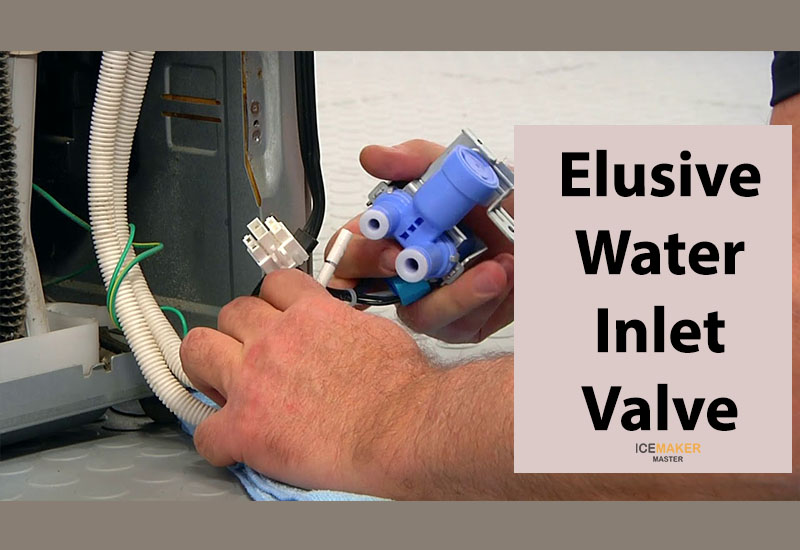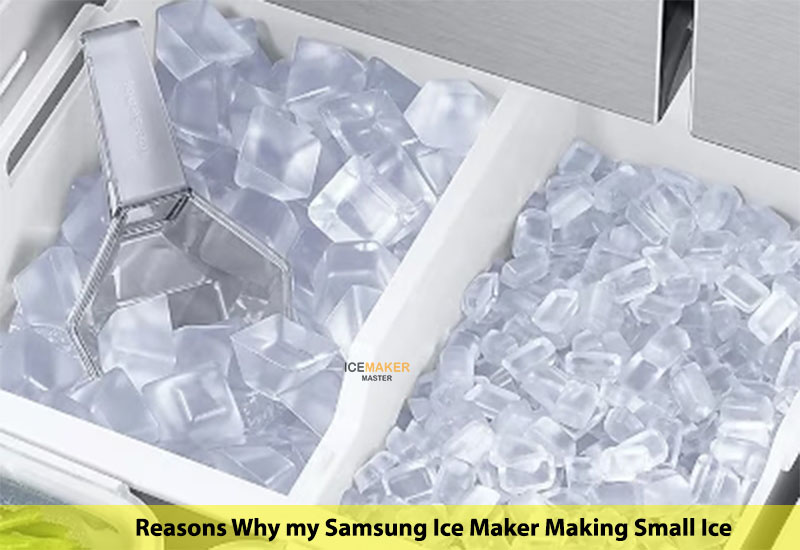Consider a hot, sunny day in the summer when the sun shines fiercely. You get yourself a drink and look forward to a cold gulp but before you know it, all the ice in the glass will have disappeared leaving you with something less than very cold. This is where we come to know about ice makers. The most crucial part of our fridges.
Ice makers do a big job by turning a regular drink into a cool oasis. Samsung is known for its awesome and trustworthy appliances and it is a top player in the ice maker world. But, hey, even the best can hit a snag.
If your Samsung ice maker is suddenly making tiny ice cubes then don’t worry. In this blog, we will talk about 5 reasons why your Samsung ice maker making small ice. We will figure out what’s causing those not-so-cool cubes and give you some tips to fix it.
Water Pressure Woes
Imagine on a hot summer day you are super excited for a cold drink, ready for the sound of ice cubes clinking. But nope, what you get is a bit really small, weak ice bits that can’t stand up to the summer heat. This may lead you to think what’s behind this letdown? A lot of times, it’s all about the water pressure.
For your ice maker to make those big, satisfying ice cubes, it needs a good amount of water flow, about 20 psi. If the pressure is not enough, you end up with smaller ice cubes.
Here’s a simple test to test the water flow, get a bucket and disconnect the water line from your fridge’s back. Turn on the valve and see how much water comes out for about 30 seconds. If it is less than 20 psi then it is time to call a plumber they can adjust the pressure where the water comes from, making sure your ice maker gets the right amount of water.
The filter too should not be left behind. Some Samsung models have filters for water. Even though it maintains the great taste of your ice, if blocked water cannot flow as freely as before and your ice will be small. So, change your filter regularly (like every three to six months) so that this may not occur.
Insufficient Cooling Power
Has it ever happened that you open your freezer and discover tiny ice cubes instead of those large cool ones you were hoping for? It’s rather disappointing. The reason why this happens may be the fact that your fridge is not cold enough.
Making ice could be likened to Goldilocks and the porridge when the water has just reached the right temperature necessary to freeze into cubes. In case your freezer is still warm (usually around 0°F or -18°C), then water might not have frozen all through which will lead to small-sized ice cubes.

Now, the method to fix this freezing issue:
Check the Thermostat
However, here is a simple solution; use a thermometer to measure its temperature. If it goes above 0°F then modify its thermostat settings accordingly so as to achieve lower temperatures. Just remember that opening and closing frequently allows heat to get inside hence try as much as possible to keep it closed.
Overstuffed Fridge and Undersized Cubes
If your fridge is too full then it is like giving it too much to handle. This can mess with how well it cools which affects the freezer temperature too. To fix this, tidy up your fridge so air can flow better and both parts can cool like they should.
Air Circulation
Make sure the air can move around. Sometimes, frost building up around the coils inside your freezer can mess with how well it cools. Defrost your freezer now and then to keep the air flowing and avoid this problem. You can take the help of your user manual for this work.
Doing these simple things will bring back the big, refreshing ice cubes you have been missing. Keeping your freezer in good shape means your ice will always be top-notch and ready to cool your drinks.
Unclogging the Path
Imagine water flowing through a little tunnel that is ready to turn into ice cubes. But what if this tunnel gets clogged with icy bits? That is the problem causing your small ice cubes and it’s called the ice maker shroud.
Take this shroud as a small but significant route in your ice maker. It passes water along itself, fills the cast and transforms it into ice cubes. However, if some chips of ice accumulate within the path, they obstruct the water flow hence resulting in reduced sizes of the ice cubes.
To solve this problem, you need to identify where the Samsung model’s user manual is located with respect to that particular model’s shroud for its icemaker. It is usually at the back of the ice bucket. After knowing this, delicately wipe away any formed ice through a soft soap-soaked rag. Bear in mind that it is a fragile part; thus avoid using harsh chemicals or pointed objects which can cause damage.
After clearing away ice from it, wash carefully with clear water until rinsed properly then dry completely before replacing on your machine.
Also Read - Learn How to Reset Samsung Ice Maker
Elusive Water Inlet Valve
Picture your ice maker as a river impatiently rushing to its frosty fate. Nevertheless, this movement might be obstructed by the water inlet valve popularly known as a gatekeeper resulting in small ice cubes.
Consider the water inlet valve as an overseer of water flows into your ice maker. When there is something wrong with this valve, not enough water gets into it which causes small ice fragments that are miserable to have in your fridge. Well, how can one identify and fix such a problem?
Take note of the sound produced during the fill cycle; some Samsung models produce clicking sounds that may indicate problems with valves. Employ any diagnosable aspect on your make so as to browse for error codes concerning valves.
However, if a faulty valve is suspected, it’s advisable to consult an expert appliance technician. Do not attempt to repair it on your own as you may end up with more problems rather than before but instead call for the assistance of professionals who will precisely identify the defect and undertake other necessary repairs or replacements.
Ice Maker Might Need Reset
Sometimes, even the best technology can face some issues. If your Samsung ice maker goes from perfect cubes to small ice cubes, consider the power of a simple reset.
Picture your ice maker like a computer program. Occasionally give it a quick reboot which can clear minor glitches and set things right. Here’s the simple formula to reset your Samsung ice maker.
Every Samsung model is unique, so you should start with your Samsung user guide to find out how to shut off the ice maker. This can be in the form of a button or switch mounted inside the freezer.
Just let it rest for some time and consider this as a digital meditation. Some five minutes is enough. Next, turn on your ice-making machine as per the instructions given by its manufacturer’s manual and wait until it starts producing ice again.
FAQ
All Samsung ice maker models can use these troubleshooting tips, can’t they?
While the five major reasons mentioned here are common to various Samsung models, the specific steps for troubleshooting may vary depending on which model you have. Always refer to your user manual for proper instructions.
How often should I replace my water filter?
Samsung recommends that you replace your water filter every three to six months, so as to ensure optimal water flow and deal with issues such as small ice cubes.
Can I use bleach or other harsh chemicals to clean the ice maker shroud?
No way! Bleach and similar substances would ruin it along with other parts that have been built into it. Instead, use warm soapy water for a safe and effective cleaning.
What are some signs of a faulty water inlet valve?
Other signs include no clicking sounds during fill cycles, strange noises from the machine, smaller smaller-sized cubes being made among others.
Is there a way to monitor my freezer temperature continuously?
Some newer Samsung models even come equipped with built-in temperature sensors that are accessible via smart apps. Alternatively, you could use an appliance thermometer separately.
Is there anything else I can try to solve the problem other than what has been discussed in the blog post?
For further troubleshooting tips that are model-specific, consult your Samsung user guide or online resources. Keep in mind that with complex issues it is always best to involve professionals.
Conclusion
I have then given you five reasons why your Samsung ice-maker is making small ice. For instance, each part provided simple steps that would help you find out if the water pressure is getting low. Nonetheless, a quick reset may resolve this issue but for such hard cases be sure to get a trained technician. With a bit of research and these useful ideas, you will be back to enjoying large coolers very soon.
Also remember If you have tried these troubleshooting steps and your ice maker still produces small cubes, it’s best to consult a qualified appliance repair technician. Such experts understand the problem and can make necessary repairs to restore the normal functioning of your ice maker.

